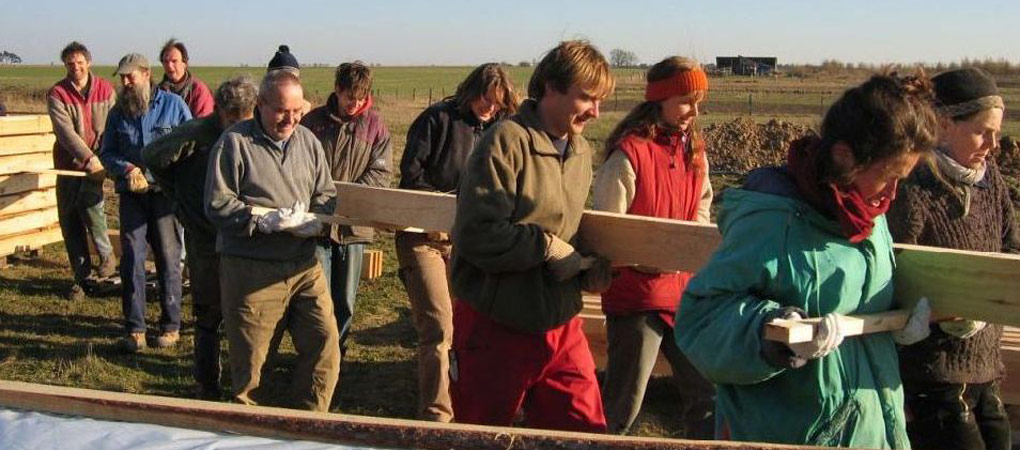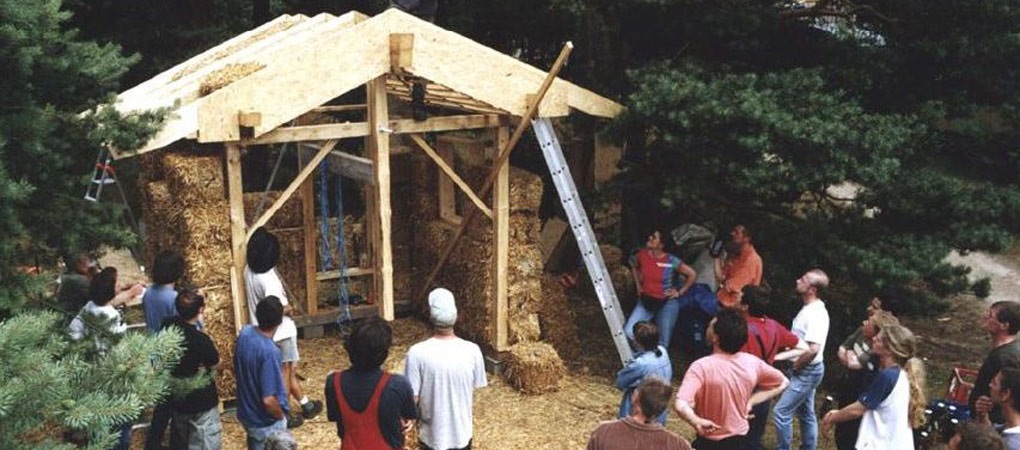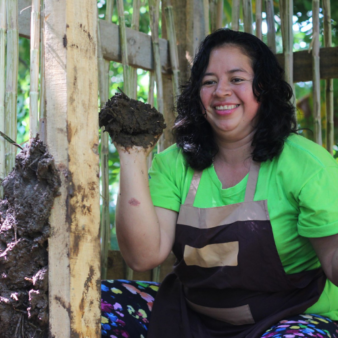Situated in the rural Altmark area of former East Germany, Sieben Linden is a community-initiated eco-village based on principles of self-sufficiency and self-determination, with accommodation for 300 people on completion. The buildings have been constructed using straw-bale, timber and clay and include the largest straw-bale building in Europe: a three storey apartment block for 20 people, and the first in Germany to receive full regulatory approval.
Project Description
Aims and Objectives
- Developed to explore practical solutions for creating a more sustainable lifestyle, the Sieben Linden Ecovillage aims to provide a model for a future way of life in which work, leisure, economy, ecology, urban and rural culture can find a balance.
- The project seeks to combine modern and traditional construction knowledge in the buildings that are developed on the site.
Project context
Borne out of initial meetings between the German Straw-bale building association (FASBA) and Freundeskreis Oekodorf (FO) held in 1989, the Sieben Linden Eco-village was established in 1997 and is situated in the Altmark area of the former East Germany.
Altmark is a flat and sparsely populated rural area between Hamburg and Magdeburg. Large-scale industrial agriculture is the norm and unemployment is high at over 20 per cent. Many young people have moved away to the cities in search of work. This has further contributed to rural decline and the downward spiral of poor services, loneliness and the increased dependence on the car.

FO and FASBA have pooled their expertise creating the Sieben Linden Ecovillage to meet the challenges facing the Altmark region. FO works to promote the ideas of ecovillages and a sustainable lifestyle and runs approximately 100 seminars and workshops annually. FASBA works to advance and promote the straw-bale construction method throughout Germany and across Europe.
Founded on self-sustaining principles, Sieben Linden has its own water, waste disposal and heat supply using wood and solar power. It owns 42 hectares of land, consisting of 25 hectares of forest, six hectares housing and 11 hectares of gardens and farmland. Currently housing 70 adults and 30 children, the Eco-village will accommodate 300 people when the project is completed.
Key features
At the heart of the project has been the use of straw-bales in the construction of the three main communal structures built to date. These buildings comprise of a community centre with temporary accommodation for 20 visitors (Villa Strohbund); a three-storey apartment block with permanent accommodation for 20 people, which is the largest straw-bale building in Europe (Strohpolis), and a combined accommodation and community centre with seven apartments and communal space for 15 people (Brunnenweise Neighbourhood). The first houses were built in 2000 and two further buildings are currently in development. The buildings are designed to significantly reduce the average ecological footprint of construction and living, and serve as useful demonstration models for training and development programmes.
All buildings are owned co-operatively, although slightly different finance models are used within the different ‘neighbourhoods’ existing at Sieben Lindeen. Low-income households can afford to construct a good quality, comfortable and healthy home and in February 2006 straw-bales were recognised as an approved building material by the Deutsches Institut für Bautechnik (the German building regulatory authority). This was the first such approval given in Europe.
Structure and Lifestyle
The village community is made up of smaller communities called ‘neighbourhoods’, each with their own conceptual approach and way of life. This creates the space for people with completely different ideals to co-exist. Different groups occupy a whole spectrum of approaches to communal living. The radical ‘Club 99’ group, with a Vegan membership, has a completely shared economy. They cultivate their food using draught horsepower, working without machinery. Other groups have more conventional cooperative arrangements. One group came together simply for the practical reason of sharing childcare.
This project was established as an intentional community, one of its primary purposes being to develop better ways in which community cooperation and participation can be encouraged and supported. Sophisticated methods of cooperative decision-taking have been established. A move away from 100 per cent consensus decision-taking has been necessary as the community has grown larger. Living and working in a community provides countless possibilities for individual and cooperative empowerment and a rich social life. Sharing communally-used facilities helps to promote contact and cooperation between people of different ages, skills, education and origin. Emphasis is put upon building communal structures before building private accommodation.
Members of the project are encouraged to become involved in local politics. The community as a whole supports these activities, encouraging a greater level of action and involvement. The weight of this participation and increased voice has resulted in successful outcomes campaigning on local issues.
Covering costs
The project is self-funding, with no reliance on external funding sources. Most of the residents work, either as self-employed, or in the local community. The unemployment rate in the community of 14.6 per cent is less than the local average of 20 per cent. Low rents are paid to the cooperatives who own the buildings.
The land itself was very cheap to buy as it is in an area of low demand. Forty-two hectares and two old buildings were purchased for US$ 284,000. The three houses built to date differ greatly in cost as they have used varying amounts of self-help labour. The Villa Strohbund cost less than US$ 323 per m2 compared to US$ 1,670 per m2 for Strohpolis and US$ 1,613 per m2for Brunnenwiese. The costs are equivalent to standard, conventional, construction costs in Germany, which are between US$ 1,420 – US$ 1,940 per m2. However, the money paid for straw-bale construction goes to the local agricultural industry and to local workers, including some residents. This has given a much needed boost to the local economy.
The costs have been met by the future residents themselves and through bank loans. Residents invested their own funds in the cooperative and these funds will be returned to them if, and when, they leave. Investments have also been made in the form of residents contributing their own labour to the construction of the buildings, and receiving compensation for doing so.
Impact
This project has given the residents a greatly increased quality of life. Homes are affordable, and the community provides a healthy living environment. Strong social cohesion and integration provides an effective supportive network for residents. The local economy has benefited as farmers have a market for their straw and local construction firms and craftsmen have been employed. The Ecovillage also provides an opportunity for local excursions in an area where there are few attractions. The residents have been politically active locally to ensure that local public transport services are retained.
Several key indicators of the project’s success include:
- Recognition of straw-bale construction as an approved building method under the German construction codes.
- The increasing number of people who wish to become part of the Ecovillage.
- High levels of demand for the straw-bale construction training programmes.
- The people who live in the houses are very happy with the quality of their homes.
- Increasing awareness of the straw-bale technologies by architects and craftsmen.
- Establishment of the first manufacturer of approved straw bales, Baustroh Ltd, which delivers straw bales all over Germany using straw from local fields, controlling the quality and making it into building blocks.
Why is it innovative?
- Construction of the first three-storey building made of straw, timber and clay in Germany with full regulatory approval (Strohpolis).
- The application of Vegan building construction methods (Strohpolis).
- Development of a model for sustainable living and building.
What is the environmental impact?
The project makes use of environmentally-sustainable materials that are locally sourced, such as straw, clay, timber, and glass. Using locally-available materials helps to reduce production and transportation costs. The production of an average family house using straw-bale saves 25 tons of CO2 when compared to an equivalent building insulated with mineral wool. The design also seeks to minimise construction waste and the houses can eventually be recycled. The materials are absorbed back into the natural cycle without leaving polluting residues.
Research studies undertaken by the University of Kassell in 2002 showed that the CO2 emissions per capita were 72 per cent lower in Sieben Linden than the average German household. Especially large reductions were achieved for space heating, where the community recorded reductions of 90 per cent compared to the national average.
The houses need only 50kWh/m² or less per year and comply with the German definition of low-energy housing. All electricity used is produced using photovoltaics (PV). Drinking water comes from a well in the village and waste water is cleaned by reed beds before being used for irrigation in the vegetable gardens and orchards. Dry composting toilets reduce the level of water consumption. Fuel wood from local forests is used for heating and water is warmed using solar energy.
The project avoids all building materials that have a large negative impact on the environment, for example plastics. The area that can be built on is limited to 16m² per person, to keep the amount of soil that is covered as small as possible, and maximising the ground area available for agriculture and other activities.
Is it financially sustainable?
Sieben Linden is not reliant on external funding sources. Self-help and self-reliance are encouraged rather than dependence on external employment, materials and energy.
The money that is paid for straw-bale construction is not given to large corporations or paid to cover transportation costs, but is rather invested in the local agricultural economy and in local workers. Although the costs for straw-bale construction in Germany are approximately equivalent to conventional construction, most of the cost is for the wages of those who build and plaster the walls, thereby reinforcing the local economy.
The locally-available, low-cost materials can be used in the building process by unskilled workers and this enables households on low incomes to provide themselves with good quality homes with reduced ongoing water and energy costs. The current recommended straw-bale building system of FASBA is particularly suitable for do-it-yourself building as it involves an infill rather than a load-bearing system. The maintenance of the buildings also uses low-cost materials and does not require high skill levels. Low energy consumption reduces the risks of being exposed to rising energy costs as world energy supplies become increasingly scarce.
What is the social impact?
Sieben Linden has been established as an example of communal living. One of its priorities has been to develop better ways for communities to live and work together. Based on principles of self-determination, all decisions made throughout the project are a result of community participation.
Living in different ‘neighbourhoods’ has enabled diverse approaches to communal living to be formulated, explored and applied. Some groups share their entire economic resources, and others live following more conventional cooperative approaches. Within the founding principles of self-sustainability and self-determination, a variety of approaches is encouraged. Living and working in a community offers many opportunities for individual or cooperative empowerment. Social integration is a natural consequence of community living. Rich social lives emerge, and the sharing of communal facilities promotes contact, cooperation and integration between people of varying education, skills and origins.
The building process has further encouraged people to engage with and depend upon each other, and to learn handicrafts and skills enabling them to fulfil their own basic needs. An emphasis on building communal structures before building private accommodation has further enhanced the community cohesion. The use of natural materials for construction, including straw and the thick clay plastering, provides healthy, comfortable living environments.
The community works actively to support the involvement of its members in local politics. A significant impact has been made, particularly in the area of maintaining local community facilities and services, and also in various lobbying campaigns, an example of which has been the successful protest against genetically modified food.
Barriers
- The lack of recognition by the German building regulatory authority that construction with straw-bales was an acceptable building method. This was overcome after a series of technical tests had been carried out to examine the technology and approval was given in February 2006.
- A lack of manuals and written guidance on straw-bale construction systems. These have now been prepared but need to be constantly improved and updated. Running a series of training courses and internships has helped to increase knowledge of the construction process.
- A need for practical demonstration projects. This has been overcome in part with the construction of the three buildings.
Lessons Learned
- Straw is an excellent building material, especially if the technical guidance on harvesting and plastering is followed. The Strohpolis building shows that it is entirely possible to construct a multi-storied building using wood, straw and clay.
- Working with volunteers required precise organisation and focus, otherwise the work can take a long time and mistakes occur more frequently.
- Saving money through working with volunteers is possible if there is a high degree of organisation to facilitate the work of ‘unskilled’ guests.
- Whilst trying to obtain building permission, it is helpful to approach the officials with a friendly and cooperative attitude, trying to reach a true understanding of what the law requires without compromising principles and purpose.
- Making knowledge available to many interested visitors is a demanding task, but is worth the long-term contribution to improving the sustainability of our lifestyles.
- In the future, developing these teaching and informative activities into paid jobs will help to ensure their availability and contribute to the financial needs of the inhabitants of Sieben Linden.
Evaluation
A simple footprint analysis was carried out to show that the whole construction process needed less than five per cent of the average energy input compared to standard ecological house building. A more detailed footprint analysis is currently being undertaken by the Technical University of Berlin. Monitoring of energy usage is also regularly carried out.
Transfer
FASBA promotes the construction methods regionally, nationally and internationally and organises internships on the straw-bale construction sites. The project has been enlarged and one of the newly- constructed buildings is to be finished in 2007 accommodating 20 people. Two others will be finished at the end of 2007 for 15 people to start living in them.
Local architects have shown an interest in the technology and are looking to develop similar buildings locally. The number of straw-bale houses has doubled within the last 16 months and now stands at 50. Three schools are currently being designed for construction using straw bales. Funding for straw-bale construction is now available from the German Ministry of Agriculture. The change of the building regulations to permit straw-bale construction has had a positive influence around the world, particularly as Germany is well known for its strict building codes.
Networking is carried out with similar projects that are being established in the USA, Denmark, Scotland, Estonia and Croatia. Since 2002 regular events have been held with an international emphasis in order to share the experience of straw-bale construction more widely. Requests for advice and consultancy services are received from all over Europe.
Partnership
National Government, professional, private sector, local community



